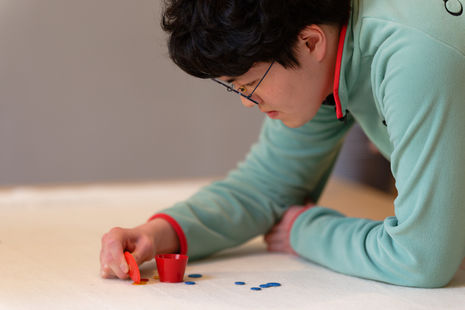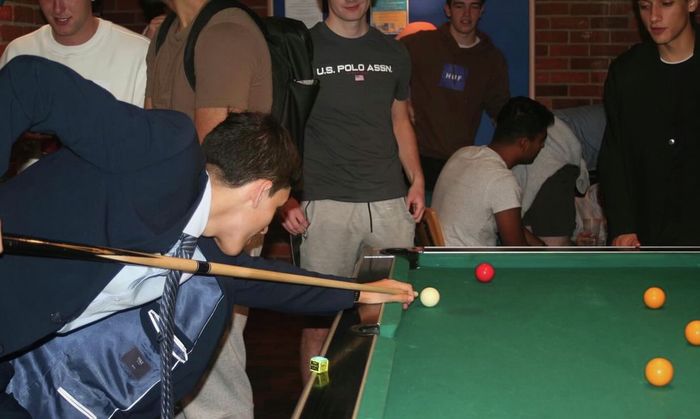Tiddlywinks: Serious tactics, silly names
Cambridge has dominated tiddlywinks, with an unbelievable Varsity record and the world’s number one. Will McLaughlin goes to a practice to find out why

Squidging off
It is November 1954 and two Cambridge students are trying to work out how to get a Blue. Neither RC Martin nor Bill Steen were athletes, so the project seemed a difficult one, but what they lacked in sporting prowess they made up for in initiative. According to Steen’s letters, starting surf bathing was too complex logistically, tree-felling was impossible in the fen land, and zoos weren’t keen on leasing their camels out for students to race on. So they settled on a children’s game about flicking counters into a pot. On 16 January 1955, six undergraduates and a chaplain met in Bill Steen’s room in Christ’s, and the Cambridge University Tiddlywinks Club (CUTwC) was born. A parlour game with a silly name had been transformed: it was now an international sport.
70 years later and I am stood in Newnham College to experience the wonders of winking in that very same club. More than 30 eager students, five practice tables, and the world No. 1 ranked winker, Patrick Barrie, fill the Jane Harrison Room in preparation for practice. Two kind members of the club, Hannah and Jack, agreed to teach me the game.
The fundamental aim of Tiddlywinks is to flick small counters, or “winks”, into the central pot with your big counter, or “squidger”. After practising these pots I had to learn the key to tiddlywinks’ complex strategy: the “squop”. A squop is when you land your wink on your opponent’s and thereby freeze their wink out of the game. When the points are finally counted, a squopped wink will count for zero where a free wink will count for one, so winkers must be constantly aware of how they might squop, be squopped, or re-squop an established squop to free themselves. After this preliminary training I was ready to start the game, and we squidged off.
The game develops
In the first few years after 1955, Cambridge dominated tiddlywinks. The usual strategy for a two-man team was for one to aim for the pot and one to aim for the squop, disrupting the other team. The game was won when the first person had all their winks in the pot, or “potted out”. In 1961, however, this all changed, because Oxford University had innovated a new, and highly annoying strategy: both players squopped. With these devious tactics they ground out two- or three-hour games and won both the Silver Wink (the cross-university trophy) and the Varsity match. Rules had to be changed, and a 25-minute time limit was introduced.
That 25-minute time limit was ticking down as I tried to squop and pot in my game with Jack and Hannah. I also had another teacher, however: Patrick Barrie, a Chemical Engineering DoS at Emma, but in his spare time the No 1 ranked tiddlywinks player in the world. As he demonstrated technical shots and strategy to me, he also unknowingly demonstrated the unbelievable skill of top level players. An incredible deftness of touch allowed him to place his winks wherever he wanted, and it was matched by a keen tactical awareness of what the other player might be able to do two, three or four moves in advance.
I asked him about his career and especially Varsity matches, but generally Oxford didn’t pose much of a threat (in 35 Varsity matches Cambridge has won 31). It was the Americans that were his greatest rivals. I then asked him for his favourite Tiddlywink term, of which there is a great number to be found on the CUTwC website. John Mapley created it when he found himself on the top of a pile of winks. Not only was he able to send the opponent’s wink far out of play, a “boondock”, but he also managed to squop another wink at the same time. He was asked what he wanted to name his new shot, and because John Lennon’s assassination occurred just days earlier, he settled on “The John Lennon Memorial Shot”. It becomes a Paul McCartney if you miss.
The final rounds
In 2019 COVID was disrupting hospitals, schools and businesses, but more importantly it was threatening the survival of tiddlywinks. Bertie, the CUTwC publicity officer, told me that while Cambridge’s continued, many other university Tiddlywinks clubs disbanded. The winking world looked bleak. But things are changing. With over 200 sign-ups at the Freshers’ Fair, Cambridge’s club is going strong, and Oxford have committed to restarting the Silver Wink trophy. There are also international links resurging, with the Smith Lady’s Undergraduate Tiddlywinkers (SLUTs by acronym) restarting their historic club in Massachusetts. There’s hope for the future, and right now is a great time to get into winking.
As the final rounds of my game came to a close, Bertie told me that the end of practice did not mean the end of the night. They introduced me to the “casual winker, serious drinker”, a concept I could readily get behind as we walked to The Mill for a few more rounds. I continued to talk winks as we played a variety of drinking games, and was infected by the joy that surrounded the game.
I had a fantastic evening, and came to respect not only the funny traditions, but the serious tactical and technical ability that tiddlywinks required. I realised however that the reason for Cambridge’s enduring tiddlywinks success, and ability to survive while other University clubs disbanded and reformed, was nothing to do with technical ability or tiddlywinks aptitude, but because of the community. Older tiddlywinks players like Patrick come back to the club to pass down the game’s obscure social traditions and culture, and by entering the sport you are also entering a vibrant social space. “I joined as a joke and last year became the president,” said Bertie. “I know it’s silly, but I love this club so much.”
 News / Uni members slam ‘totalitarian’ recommendation to stop vet course 15 January 2026
News / Uni members slam ‘totalitarian’ recommendation to stop vet course 15 January 2026 News / Cambridge bus strikes continue into new year16 January 2026
News / Cambridge bus strikes continue into new year16 January 2026 Science / Why smart students keep failing to quit smoking15 January 2026
Science / Why smart students keep failing to quit smoking15 January 2026 Interviews / The Cambridge Cupid: what’s the secret to a great date?14 January 2026
Interviews / The Cambridge Cupid: what’s the secret to a great date?14 January 2026 Comment / Will the town and gown divide ever truly be resolved?12 January 2026
Comment / Will the town and gown divide ever truly be resolved?12 January 2026









